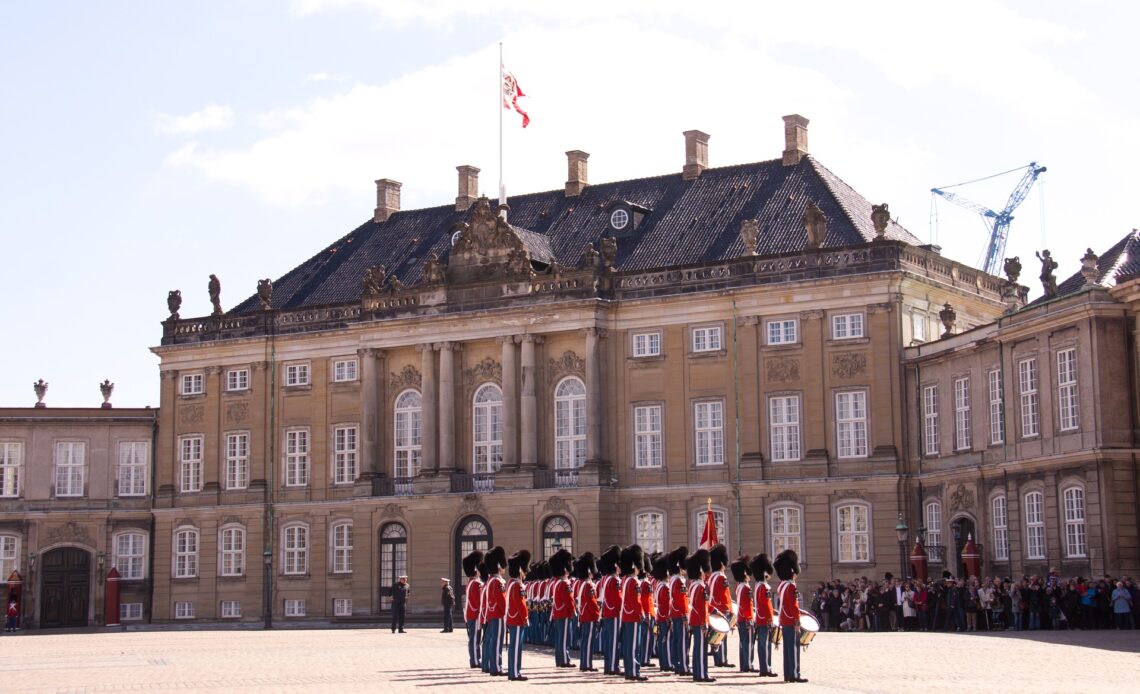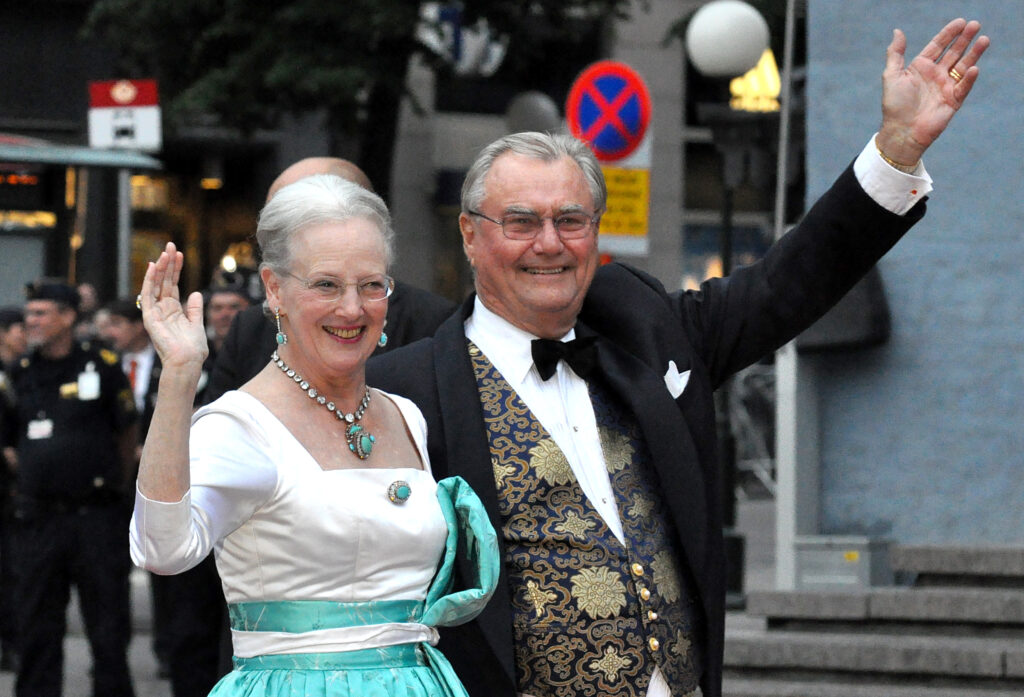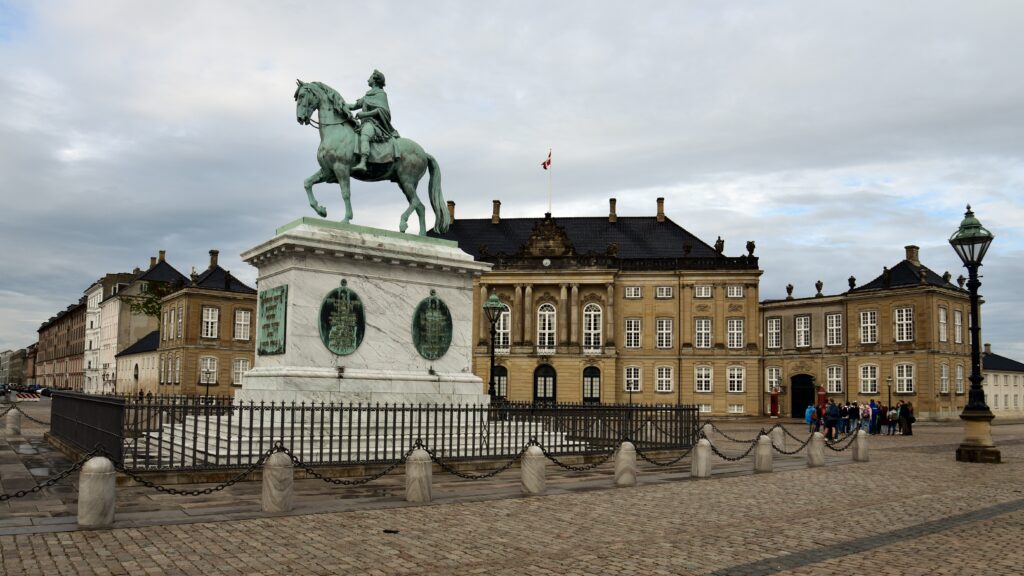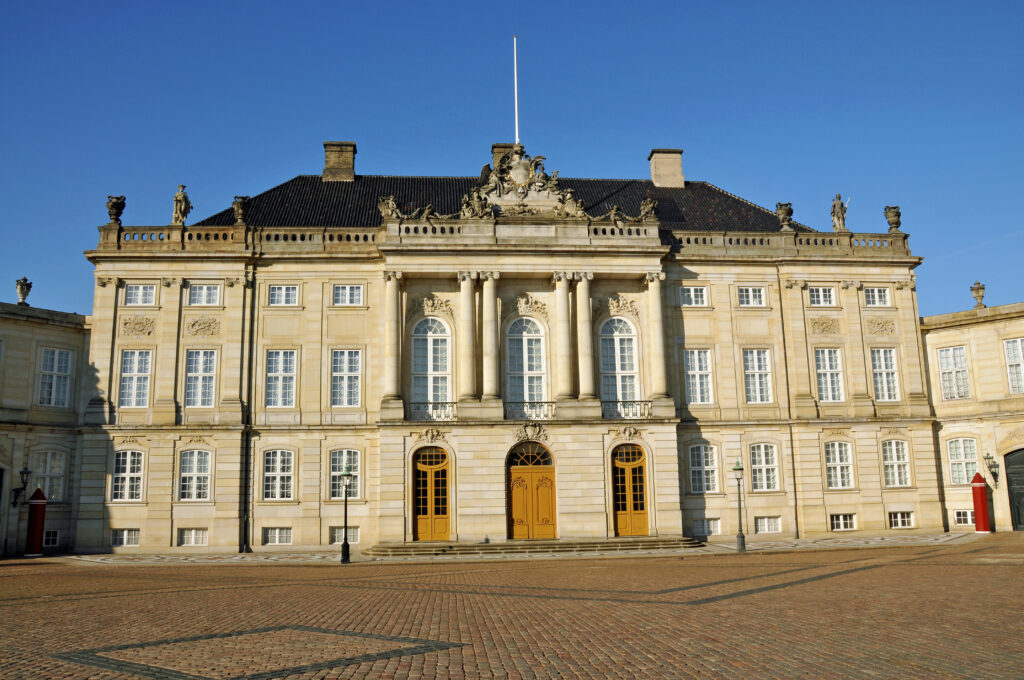
Amalienborg Palace, located in Copenhagen, Denmark, is the primary residence of the Danish Royal Family. Queen Margrethe II of Denmark was born there on 16 April 1940, during the reign of her predecessor and grandfather, Christian X. Besides being the birthplace of the first Danish queen to reign in seven hundred years, it has a long and illustrious history.
Amalienborg is made up of four palaces that surround an octagonal courtyard. In this courtyard, there is a statue created by French sculptor, Jacques-François-Joseph Saly, that portrays King Frederik V on horseback. Frederik V was the founder of Amalienborg and Frederiksstaden, the district where the palace is located.

The Origins of Amalienborg
According to Amalienborg Palace, it is located on the site where Sophie Amalienborg, an earlier palace, once stood. It was named for King Frederik III’s queen consort, Sophie Amalie of Brunswick-Calenberg. Queen Sophie Amalie intended for the opulent Italian-style villa to be her summer palace, and it was the site for many important court festivities. Even though the palace was constructed between 1667 and 1673, it was destroyed in April of 1689, when it went up in flames. Sophie Amalie’s son, King Christian V, was celebrating his birthday when the fire occurred. The tragedy resulted in the loss of about 180 lives.
Information provided by the Danish monarchy sheds light on how the palace and district were built. For decades after the destruction of the original Sophie Amalienborg, there was discussion about what would be built there. In 1748, to mark the House of Oldenburg’s 300th Jubilee, Frederick V ordered the creation of Frederiksstaden, a new district of Copenhagen. The Lord High Steward, Adam Gottlob Moltke and the master court builder, Nicolai Eigtved oversaw the creation of this new district. In its purest form, Frederiksstaden was intended to be an ideal society and the town plan, as created by Eigtved, demonstrates that. The statue of the King on horseback represented the ruler who received his royal power directly from God. For this reason, the statue faced Frederik’s Church (God), and it was surrounded by the residences of the nobility (Amalienborg Palaces).

Eigtved, who was a proponent of the Rococo style, chose to design Amalienborg Palace in this way. The four palaces that make up the complex help to create an octagon that surrounds the statue of Frederick V. It is believed that Eigtved found his inspiration from the Place de la Concorde, in Paris. Eigtved’s style married together a soft rococo influence and various aspects of the French and German styles. While the exteriors of these palaces look very much the same, the interiors differ a great deal.
Originally the Amalienborg Palace complex was intended for prominent families of Denmark’s aristocracy. In fact, the best palace was reserved for the Lord High Steward, Moltke. However, this changed in February of 1794, when there was a fire at Christiansborg Palace, then the residence of the Danish Royal Family. After this point, the Royal Family made Amalienborg Palace a royal residence.
Christian VII’s Palace
Built between 1750 and 1754, Christian VII’s Palace initially belonged to the Lord High Steward, Adam Gottlob Moltke. In the aftermath of the fire at Christiansborg Palace, King Christian VII purchased the palace from Moltke. Situated at the southwestern corner of the complex, this palace was one of the most expensive and opulent palaces of its day. Eigtved hired only the best craftsmen and artists to create an extravagant palace.

After it became a royal residence, Christian VII ordered Caspar Frederik Harsdorff, a Danish architect in the neoclassical style, to prepare it for the Royal Family. Christian VII and his family moved into the palace in December of 1794. According to Danish archivist and historian Carl Frederik Bricka, Harsdorff superintended numerous alterations that only caused further improvement of the palace’s appearance. Among the changes was the construction of a Colonnade that joined the two southernmost palaces, the Christian VII and Christian IX Palaces. This was added to make it easier to move between palaces. The Ionic columns created a closed passage that created privacy for the Danish Royal Family.
According to the Danish monarchy, Christian VII’s Palace is Queen Margrethe’s representative residence.
Christian VIII’s Palace
Built between 1750 and 1760, Christian VIII’s Palace originally was intended for the Privy Counsellor, Count Christian Frederik Levetzau. This palace is located at the northwestern corner of the complex. While Nicolai Eigtved started the building, he passed away in 1754 and did not live to see it completed.
According to the Danish monarchy, then Heir Presumptive, Frederik purchased the palace in 1794 and immediately set to work modernising it. The Prince charged neoclassical painter and architect, Nicolai Abildgaard with the task of renovating the palace in the French Empire style. After Frederik passed away in 1805, his son Christian (who would later become Christian VIII) took control of the palace and its renovations. When Abildgaard passed away in 1809, all renovations stopped.
This palace is the current residence of Prince Joachim, Princess Marie, their children and Princess Benedikte.
Frederik VIII’s Palace
Frederik VIII’s Palace is located towards the northeastern corner of the complex. Built between 1750 and 1760, this palace was originally intended for Baron Joachim Brockdorf. When Brockdorf passed away in 1763, the Lord High Steward, A.G. Moltke took possession of the palace. In 1765, Moltke sold the palace to Frederik V. Thereafter it was utilised as the residence for Army Cadet Academy until 1827, according to the Danish monarchy.
In 1828, when Frederik IV’s daughter, Princess Vilhelmine, married the Heir Presumptive, Prince Frederik, they took up residence in the palace. Since the marriage was an unsuccessful one, it was eventually dissolved in 1837. After this event, Prince Frederik (the future Frederik VIII) moved into the palace in 1869 and lived there with his family thereafter. Prince Frederik ascended to the throne in 1906.
This palace is the current residence of Crown Prince Frederik, Crown Princess Mary and their four children. They moved into the palace after it was renovated in 2004.
Christian IX’s Palace
This palace is situated towards the southeastern corner of the complex. Nicolai Eigtved started building Christian IX’s Palace in 1750. It was originally intended for the Privy Counsellor, Severin Løvenskiold, but he was forced to give up the building due to financial duress. Countess Anne Sophie Schack later took possession of the palace, and she gave it to her grandson, Hans Schack. After Hans married the Lord High Steward, Adam Gottlob Moltke’s daughter in 1757, the building of the palace continued once more. Moltke sent the craftsman and artists working on his palace to work on his son-in-law’s palace.
Once the Christiansborg fire occurred in 1794, the palace was purchased for the Prince Regent, Frederik (who later became Frederik IV). Starting in 1784, he served as Prince Regent when his father, King Christian VII, was unable to rule the country. Frederik eventually became King of Denmark in 1808. When he passed away in 1839, the palace was used to house the Ministry of Foreign Affairs and the Supreme Court. In 1863, the palace was taken over by Christian IX who lived there for the rest of his life.
Queen Margrethe currently uses this palace as her winter residence.

